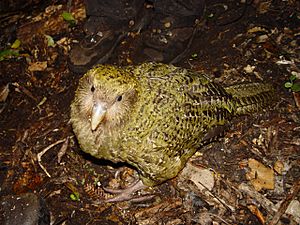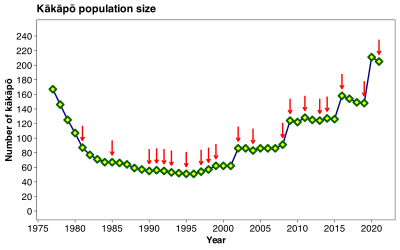List of kakapo facts for kids

The kākāpō is a large, flightless parrot that lives in New Zealand. It is a very special and rare bird, with fewer than 250 living kākāpō left in the world. Because they are so rare, every known kākāpō, except for some young chicks, has been given a unique name by the people working to protect them in the Kākāpō Recovery Programme. Many older birds have English names, while newer chicks often receive Māori names. Some kākāpō are even named after people who have helped save them, like Richard Henry and Moorhouse. You can even find an interactive family tree for the kākāpō!
Kākāpō Population: What's Happening?
The number of kākāpō changes often. After a successful breeding season in 2002, the population stayed at 86 birds until 2004. Sadly, three young female kākāpō died that year from a soil infection. In 2005, four chicks hatched, but then a male kākāpō named Gunner passed away, bringing the total back to 86.
In April 2008, seven new chicks hatched, increasing the population to 93. However, the death of an adult bird named Bill soon brought the number down to 92. Another chick died, and then a male named Lee passed away, leaving 90 kākāpō. A male named Rangi was found again in February 2009 after living on Codfish Island for 21 years!
The 2009 breeding season was a big success, with 33 chicks hatching (20 males and 13 females). This brought the population up to 124. Some older birds died in 2010, including Richard Henry, who was the last kākāpō from the Fiordland area. Luckily, his unique genes live on through his three children.
In 2011, 11 more chicks hatched, and all of them survived, making the population 131. But after some birds died and there was no breeding season in 2012, the number dropped to 124. By May 2014, six new chicks hatched, bringing the total to 130 living kākāpō.
The 2016 nesting season was a "record breeding season" with 47 chicks hatching! By July 2016, 34 of these chicks had survived. Today, the New Zealand Department of Conservation website shows a population of 204 kākāpō.
Meet the Living Kākāpō! (204 Birds)
Every kākāpō has a name, which helps the conservation team keep track of them. These names often reflect their heritage, with older birds having English names and newer chicks receiving beautiful Māori names. Some are even named after the people who helped save them!
The kākāpō population includes both females and males. The team carefully monitors each bird, noting their birth year, their parents, and any special characteristics. For example, Sirocco is a famous male kākāpō who is well-known for his friendly personality and has even been a "spokesbird" for conservation. Ruth is another special female who is blind in one eye.
The dedicated team tracks each kākāpō's life, including who their parents are and if they have had any chicks. This information is important for understanding their family lines and planning future breeding efforts to help the population grow.
Helping the Kākāpō: Fundraising Efforts
To help raise money for important research and care, the New Zealand government's Department of Conservation runs a special kākāpō adoption program. When you "adopt" a kākāpō, you don't actually own the bird. Kākāpō are considered a taonga, which means a treasured species, and they belong to New Zealand.
This symbolic adoption helps fund many important things. Your support can go towards managing the kākāpō's health, providing extra food when needed, and changing their tracking transmitters every year. It's a great way for people to contribute to the survival of these amazing birds.
Kākāpō Who Have Passed Away
Sadly, like all living creatures, some kākāpō have passed away over the years. The conservation team keeps records of these birds, which helps them understand the challenges the kākāpō face. Some birds have died from natural causes like old age or illness, while others have been lost due to accidents or infections.
There are also some kākāpō who are marked as "missing, presumed dead" (shown with a ‡). This means they haven't been seen for a very long time, and it's likely they have passed away, perhaps due to predators or getting lost.
Each kākāpō that has passed away, like Hoki (the first hand-raised bird) or Richard Henry (the last kākāpō from the South Island), contributed to the knowledge and efforts to save their species. Their lives, and their deaths, help the conservation team learn more about how to protect the remaining kākāpō.


